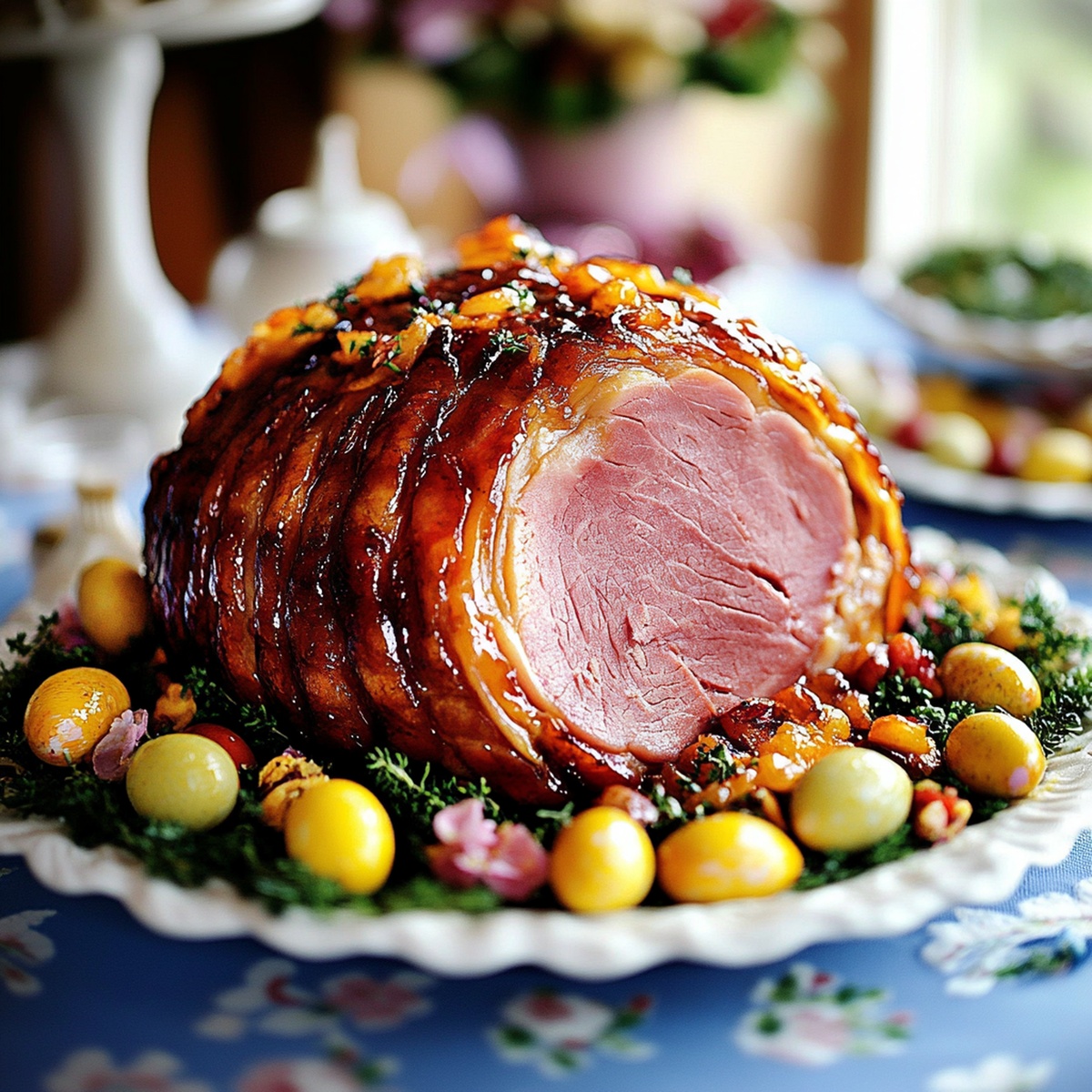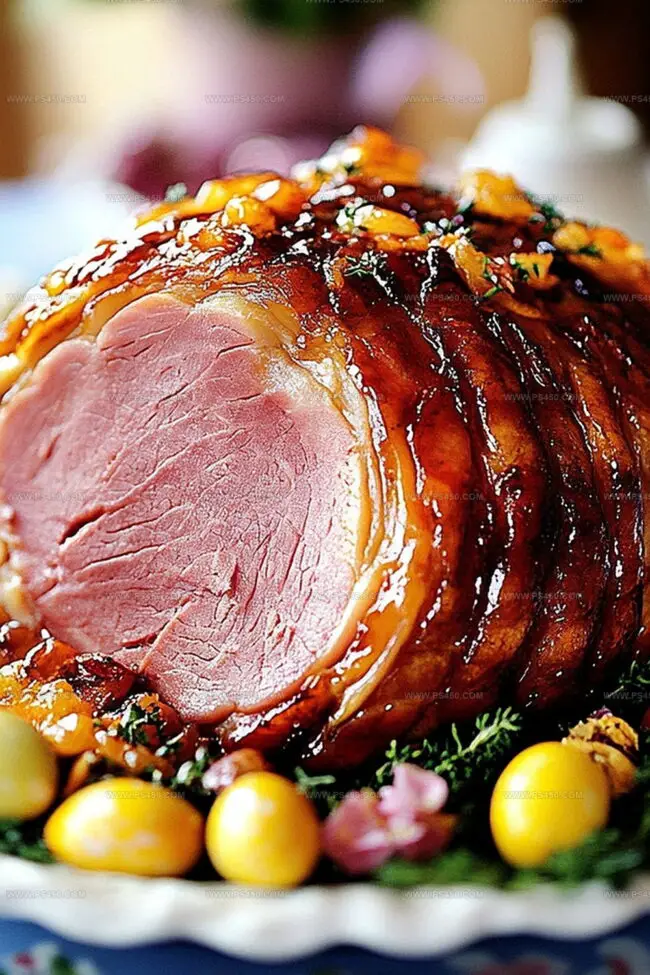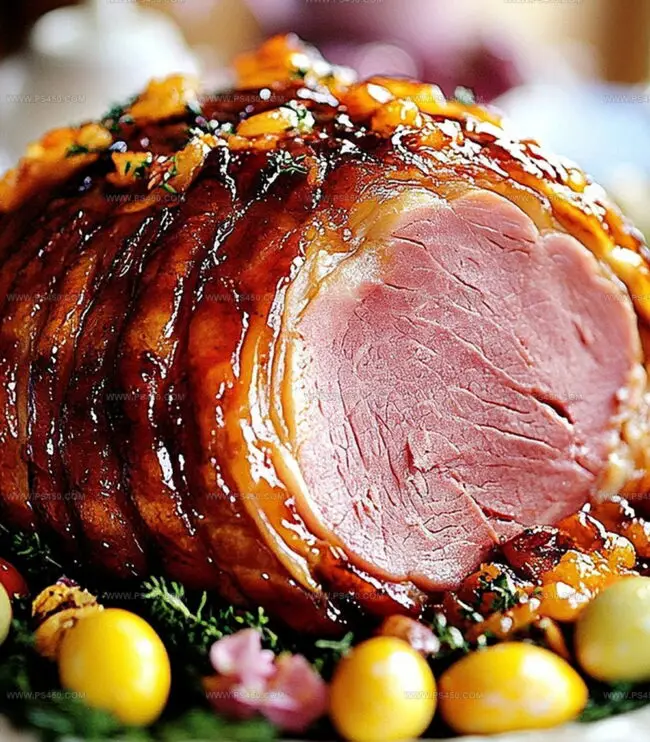Glazed Easter Ham Recipe That Wows at Family Feasts
Ham has become a centerpiece of many celebratory Easter gatherings around the world.
Rich, succulent meat transforms an ordinary meal into something special.
Families eagerly anticipate this classic dish with its sweet and savory glaze.
Each slice promises a delightful combination of flavors that dance across your palate.
Selecting quality ingredients makes a significant difference in the final result.
The right technique ensures a juicy, tender centerpiece that impresses everyone at the table.
You’ll want to savor every delectable bite of this mouthwatering main course.
Why Glazed Easter Ham Is Juicy, Sweet, And Holiday-Ready
What You’ll Need For Glazed Easter Ham
Meat Base:Glaze Ingredients:Spice and Flavor Enhancers:How To Bake Glazed Easter Ham Step By Step
Step 1: Warm Up The Oven
Crank your oven to a cozy 325F. Position the ham fat-side up in a spacious roasting pan. Wrap the entire pan with aluminum foil to lock in all those delicious juices.
Step 2: Slow Roast The Centerpiece
Slide the wrapped ham into the oven. Let it transform slowly, allowing about 10-12 minutes of cooking per pound. An average ham will need roughly 1.5 hours to reach perfect tenderness.
Step 3: Craft The Magical Glaze
Grab a saucepan and combine these flavor-packed ingredients:Heat the mixture, stirring occasionally until it bubbles cheerfully. Reduce heat and let it simmer, watching it thicken into a glossy coating.
Step 4: Transform With Glaze
Pull the ham from the oven and jack up the temperature to 400F. Generously paint half the glaze across the ham’s surface, making sure it seeps between slices. Return to the oven uncovered for 15 minutes. Repeat with remaining glaze, baking until the exterior turns a gorgeous caramelized bronze.
Step 5: Rest And Celebrate
Allow the ham to rest for 10 minutes, letting the juices redistribute. Slice and serve, drizzling any remaining pan glaze for extra excitement.
Pro Tip: For a show-stopping presentation, garnish with fresh herbs or citrus slices before bringing to the table.
Tips For The Best Glaze On Glazed Easter Ham
How To Store Glazed Easter Ham Without Drying It Out
Perfect Sides For Glazed Easter Ham
Delicious Variations Of Glazed Easter Ham You Can Try
Glazed Easter Ham Questions Answered
Spiral-cut hams are pre-sliced, which helps the glaze penetrate between the layers, ensuring each slice is flavorful and evenly coated with the delicious sweet and spicy mixture.
Absolutely! You can prepare the glaze up to 3 days in advance and store it in an airtight container in the refrigerator. Just reheat gently before brushing on the ham.
Yes, covering the ham prevents it from drying out and helps it cook evenly, ensuring a moist and tender result. The foil also helps retain the ham’s natural juices.
Look for a deep golden-brown color with slightly bubbling edges. The glaze should look glossy and stick nicely to the ham’s surface, creating a beautiful, appetizing finish.
Print
Glazed Easter Ham Recipe
- Total Time: 2 hours
- Yield: 12 1x
Description
Succulent honey-glazed Easter ham brings festive cheer to family gatherings with its golden-brown exterior and juicy interior. Generations of home cooks cherish this classic centerpiece that promises delightful flavors and memorable moments you’ll savor.
Ingredients
Main Protein:
- 1 (8-10 pound) bone-in spiral-cut ham
Sweeteners and Liquid Base:
- 1 cup brown sugar, packed
- ½ cup honey
- ¼ cup apple cider vinegar or orange juice
Spices and Condiments:
- ¼ cup Dijon mustard
- 1 teaspoon ground cinnamon
- ½ teaspoon ground cloves
- ½ teaspoon ground ginger
- ¼ teaspoon ground black pepper
Instructions
- Prepare the oven environment by heating to 325F (165C). Position the ham in a spacious roasting pan with the cut side facing downward, then shield the pan completely with aluminum foil.
- Roast the ham for approximately 10-12 minutes per pound, calculating total cooking time based on the ham’s weight. An 8-pound ham typically requires around 1 hour 20 minutes to 1 hour 30 minutes of initial baking.
- Craft the glaze by combining brown sugar, honey, Dijon mustard, apple cider vinegar, cinnamon, cloves, ginger, and black pepper in a saucepan. Gently heat the mixture, stirring periodically until it reaches a rolling boil. Reduce the temperature and allow the glaze to simmer, thickening slightly for 5-7 minutes.
- Carefully extract the ham from the oven and elevate the temperature to 400F (200C). Generously apply half of the prepared glaze, ensuring thorough coverage including the spaces between ham slices. Return the ham to the oven without foil and bake for 15 minutes.
- Apply the remaining glaze, creating a rich, glossy coating. Continue baking for an additional 15 minutes until the surface caramelizes and develops a bubbling, golden-brown appearance.
- Remove the ham from the oven and allow it to rest for 10 minutes, enabling the juices to redistribute. Slice and serve while warm, drizzling any remaining pan glaze over the meat for extra flavor.
Notes
- Ensure the ham is at room temperature before baking to promote even cooking and prevent dry edges.
- Select a bone-in ham for richer flavor and more succulent meat that retains moisture during roasting.
- Use a meat thermometer to check internal temperature, aiming for 140F (60C) for perfect doneness without overcooking.
- Create a versatile glaze by substituting honey with maple syrup or agave for different dietary preferences or flavor variations.
- For a lower-sugar version, replace brown sugar with monk fruit sweetener or reduce sugar content by half without compromising taste.
- Prevent ham from drying by covering with foil during initial baking and basting with glaze periodically to lock in natural juices.
- Accommodate gluten-free diets by confirming Dijon mustard is gluten-free or using alternative mustard varieties.
- Add depth to the glaze by incorporating orange zest or a splash of bourbon for a gourmet twist that elevates traditional ham preparation.
- Prep Time: 15 minutes
- Cook Time: 1 hour 45 minutes
- Category: Dinner
- Method: Baking
- Cuisine: American
Nutrition
- Serving Size: 12
- Calories: 300
- Sugar: 20 g
- Sodium: 800 mg
- Fat: 10 g
- Saturated Fat: 3.5 g
- Unsaturated Fat: 5 g
- Trans Fat: 0 g
- Carbohydrates: 40 g
- Fiber: 0 g
- Protein: 15 g
- Cholesterol: 60 mg




Emily Morgan
Food Critic & Kitchen Tips Specialist
Expertise
Global Food Exploration & Critique, Simple Kitchen Hacks & Time-Saving Tips, Presentation & Plating Techniques, Culinary Research & Storytelling.
Education
New York University
Emily Morgan has journeyed across the globe, collecting culinary secrets that turn everyday ingredients into impressive meals.
Based in Seattle and armed with a Journalism degree from NYU, she blends thorough research with a flair for presentation, ensuring every dish looks just as good as it tastes.
Focusing on fresh flavors, simple methods, and a bit of fun, Emily shows home cooks how to elevate their daily cooking without fancy gadgets or complex steps.